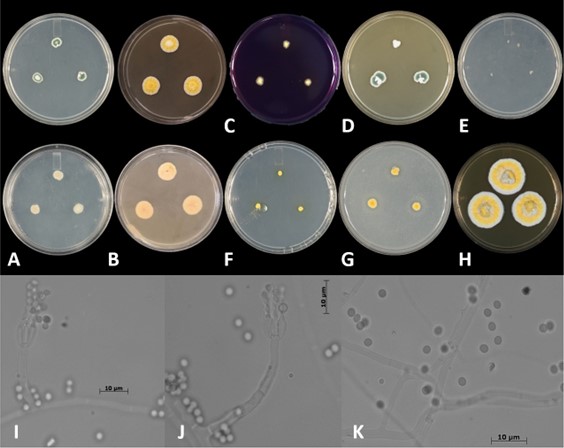Penicillium hirayamae Udagawa, J. Agric. Soc. Tokyo Nogyo Daigaku 5: 6. (1959).
MycoBank number: MB 302402; Index Fungorum number: IF 302402; Facesoffungi number: FoF 11431;
≡ Eupenicillium hirayamae D.B. Scott & Stolk, Antonie van Leeuwenhoek 33: 305 (1967)
Description
Culture characteristics: Colonies growing after 5 days at 25 ± 2 ºC on following agar media: CYA colonies slow growing, deep radial sulcations, cottony, velvety, flat, mycelium white 8–9 mm in diam.; margins irregular; sporulation greyish green (26E4); exudate absent; soluble pigment absent; reverse filamentous, mycelia reddish-orange (7A6), sporulation yellowish-white (2A2). MEA colonies medium growing, cottony, radially sulcate, flat, velutinous to somewhat floccose, mycelia chrome yellow (3A8),12–14 mm in diam.; margins irregular; sporulation yellow (3A6) to reddish-yellow (4A6); exudates present; soluble pigments absent; reverse mycelia yellow (3A6), sporulation white. CYAS colonies slow-growing, slightly sulcate, floccose, umbonate, mycelia yellow (3A7), 12–13 mm in diam.; margin irregular, deep; sporulation dark green (26F5); exudates absent; soluble pigments absent; reverse wrinkled, light yellow (3A5). OA colonies slow-growing, cottony, sporulation white, mycelia reddish yellow (3A5),7-8 mm in diam.; margin regular, flat; exudates present, deep yellow (4A8); soluble pigments absent; reverse mycelia pastel yellow, sporulation light yellow (4A4). CZ colonies slow-growing, flat, cottony, flat, mycelia greyish yellow (4B6), sporulation white, 3 mm in diam.; margin irregular; exudates absent; soluble pigments absent; DG18 colonies slow-growing, cottony, smooth, planar, mycelium light yellow (3A5), 5–6 mm diam.; margin irregular; exudates absent; soluble pigments absent; reverse white. YES colonies slow-growing, floccose, umbonate, radiating sulcate, sporulation greenish-white, mycelia pastel yellow (3A4), 18 mm diam.; margin irregular; exudates absent; soluble pigments absent; colony reverse rhizoid, white. CREA colonies cottony, slightly umbonate, suppressed, half mycelia yellow (3A8) and greyish green (26E4),5 mm in diam.; margin irregular; acid production present; soluble pigment present, light yellow (3A4); reverse colony flat, mycelia yellowish red (8B8), sporulation yellow (3A8). Conidiophores strictly monoverticillate, borne from funiculose aerial hyphae; stipes 10–50 × 2.5–3.0µm, smooth walled, with apices usually vesiculate; phialides ampulliform, 5−8 per conidiophore, 6.0−10 × 2.0−2.5μm; conidia sub-spheroidal, 1.5−3.0 ×1.5−2.5μm, smooth walled, borne in long columns.
Material examined: INDIA, Maharashtra, Thane (19°12′57″N, 72°59′31″E) from soil sample, 26 Dec 2017, Rajeshkumar K.C., Nikhil Ashtekar (NFCCI 5062).
Distribution: Thailand and South Africa
Sequence data from this collection: ITS: OK342195 (ITS5/ITS4); BenA: OL652652 (Bt2a/Bt2b); CaM: OM948801 (CMD5/CMD6); RPB2: OL652656 (fRPB2-5F/fRPB2-7CR)
Notes: The concatenated phylogenetic analyses (ITS, BenA, CaM, and RPB2 gene) aligns the isolated strain of P. hirayamae (NFCCI 5062) with the type stain, P. hirayamae (CBS22960) having a bootstrap value of 100%. Similarly, both these strains display the same morphological features such as strictly monoverticillate conidiophore branching pattern and sub-spheroidal conidia with smooth ornamentation. Hence, a new record of P. hirayamae (NFCCI 5062) from India is introduced based on the morphological and phylogenetic evidence.
Importance of species to humans or ecosystem: There is no record of any threat to humans or ecosystem
Quarantine significance: No data available regarding quarantine. Fungi belonging to BS level I
Biochemical importance, chemical diversity or application: Sclerotiorin, the main component of the sclerotiorin group of pigmented metabolite was isolated from P. hirayamae (Udagawa, 1963).
Another member of the same group, rubrorotiorin was later isolated from P. hirayamae (Gray and Whalley, 1970, 1971). dos Santos et al. (2019) suggest that sclerotiorin and the sclerotiorin group of metabolites may be used as chemotaxonomic markers in identification of Penicillium.

Fig. 1. Penicillium hirayamae. A, B Colonies after 5d at 25± 2 ºC on CYA and MEA obverse and reverse. C CREA obverse. D CYAS obverse. E CZA obverse. F DG18 obverse. G OA (natural) obverse. H YES obverse. I-J monoverticillate conidiophore. K Conidia. Scale bar: I-K=10 μm.
